How Can the Introduction of Zr4+ Ions into TiO2 Nanomaterial Impact the DSSC Photoconversion Efficiency? A Comprehensive Theoretical and Experimental Consideration
Abstract
1. Introduction
2. Materials and Methods
2.1. Computer Simulations
2.2. Materials
2.3. Preparation Method
2.4. DSSC Fabrication
2.5. Dye Loading Determination
2.6. Characterization
3. Results and Discussion
3.1. Theoretical Calculations
3.1.1. Structural Properties
3.1.2. Electronic Properties of a-TiO2 and t-ZrO2
3.2. Experimental Determination
3.2.1. Structure and Morphology
3.2.2. Physicochemical Analysis
3.2.3. Photovoltaic Characterization
4. Conclusions
Supplementary Materials
Author Contributions
Funding
Institutional Review Board Statement
Informed Consent Statement
Data Availability Statement
Conflicts of Interest
References
- Hussain, S.; Yangb, X.; Aslam, M.K.; Shaheend, A.; Javed, M.S.; Aslamf, N.; Aslamg, B.; Liua, G.; Qiaoa, G. Robust TiN nanoparticles polysulfide anchor for Li–S storage and diffusion pathways using first principle calculations. Chem. Eng. J. 2020, 391, 123595. [Google Scholar] [CrossRef]
- Hussaina, S.; Javed, M.S.; Asimd, S.; Shaheene, A.; Khan, A.J.; Abbasg, Y.; Ullaha, N.; Iqbalh, A.; Wanga, M.; Qiaoa, G.; et al. Novel gravel-like NiMoO4 nanoparticles on carbon cloth for outstanding supercapacitor applications. Ceram. Int. 2020, 46, 6406–6412. [Google Scholar] [CrossRef]
- Hussain, S.; Khan, A.J.; Arshad, M.; Javed, M.S.; Ahmad, A.; Shah, S.S.; Khan, M.R.; Akram, S.; Ali, S.; ALOthman, Z.A.; et al. Charge storage in binder-free 2D-hexagonal CoMoO4 nanosheets as a redox active material for pseudocapacitors. Ceram. Int. 2021, 47, 8659–8667. [Google Scholar] [CrossRef]
- Chetan, M.; Yao, S.; Griffith, D.T. Multi-fidelity digital twin structural model for a sub-scale downwind wind turbine rotor blade. Wind. Energy 2021, 1–20. [Google Scholar] [CrossRef]
- Ma, J.; Jiang, Q.; Zhang, Q.; Xie, Y.; Wang, Y.; Yi, F. Effect of groundwater forced seepage on heat transfer characteristics of borehole heat exchangers. Geotherm. Energy 2021, 9, 1–23. [Google Scholar] [CrossRef]
- O’Regan, B.; Grätzel, M. A low-cost, high-efficiency solar cell based on dye-sensitized colloidal TiO2 films. Nature 1991, 353, 737–740. [Google Scholar] [CrossRef]
- Aslam, A.; Mehmood, U.; Arshad, M.H.; Ishfaq, A.; Zaheer, J.; Ul Haq Khan, A.; Sufyan, M. Dye-sensitized solar cells (DSSCs) as a potential photovoltaic technology for the self-powered internet of things (IoTs) applications. Sol. Energy 2020, 207, 874–892. [Google Scholar] [CrossRef]
- Fakharuddin, A.; Jose, R.; Brown, T.M.; Fabregat-Santiago, F.; Bisquert, J. A perspective on the production of dye-sensitized solar modules. Energy Environ. Sci. 2014, 7, 3952–3981. [Google Scholar] [CrossRef]
- Rume, T.; Islam, S.D.-U. Environmental effects of COVID-19 pandemic and potential strategies of sustainability. Heliyon 2020, 6, e04965. [Google Scholar] [CrossRef]
- Khamrang, T.; Velusamy, M.; Ramesh, M.; Jhonsi, M.A.; Jaccob, M.; Ramasubramanian, K.; Kathiravan, A. IoT-enabled dye-sensitized solar cells: An effective embedded tool for monitoring the outdoor device performance. RSC Adv. 2020, 10, 35787–35791. [Google Scholar] [CrossRef]
- Michaels, H.; Rinderle, M.; Freitag, R.; Benesperi, I.; Edvinsson, T.; Socher, R.; Gagliardi, A.; Freitag, M. Dye-sensitized solar cells under ambient light powering machine learning: Towards autonomous smart sensors for the internet of things. Chem. Sci. 2020, 11, 2895–2906. [Google Scholar] [CrossRef]
- Gong, J.; Sumathy, K.; Qiao, Q.; Zhou, Z. Review on dye-sensitized solar cells (DSSCs): Advanced techniques and research trends. Renew. Sustain. Energy Rev. 2017, 68, 234–246. [Google Scholar] [CrossRef]
- Gong, J.; Liang, J.; Sumathy, K. Review on dye-sensitized solar cells (DSSCs): Fundamental concepts and novel materials. Renew. Sustain. Energy Rev. 2012, 16, 5848–5860. [Google Scholar] [CrossRef]
- Swamy, V.; Gale, J.; Dubrovinsky, L. Atomistic simulation of the crystal structures and bulk moduli of TiO2 polymorphs. J. Phys. Chem. Solids 2001, 62, 887–895. [Google Scholar] [CrossRef]
- Reyescoronado, D.; Rodriguezgattorno, G.; Espinosa-Pesqueira, M.; Cab, C.; De Coss, R.; Oskam, G. Phase-pure TiO2 nanoparticles: Anatase, brookite and rutile. Nanotechnology 2008, 19, 145605. [Google Scholar] [CrossRef] [PubMed]
- Hagfeldt, A.; Graetzel, M. Light-Induced Redox Reactions in Nanocrystalline Systems. Chem. Rev. 1995, 95, 49–68. [Google Scholar] [CrossRef]
- Hoffmann, M.R.; Martin, S.T.; Choi, W.; Bahnemann, D.W. Environmental Applications of Semiconductor Photocatalysis. Chem. Rev. 1995, 95, 69–96. [Google Scholar] [CrossRef]
- Chiarello, G.L.; Dozzi, M.V.; Scavini, M.; Grunwaldt, J.-D.; Selli, E. One step flame-made fluorinated Pt/TiO2 photocatalysts for hydrogen production. Appl. Catal. B Environ. 2014, 160–161, 144–151. [Google Scholar] [CrossRef]
- Bsiri, N.; Zrir, M.; Bouaicha, M. Effect of Cr and Zr doping of TiO2 on the opto-electrical properties of dye sensitized solar cells. Optics 2020, 207, 163888. [Google Scholar] [CrossRef]
- Unal, F.A.; Ok, S.; Unal, M.; Topal, S.; Cellat, K.; Şen, F. Synthesis, characterization, and application of transition metals (Ni, Zr, and Fe) doped TiO2 photoelectrodes for dye-sensitized solar cells. J. Mol. Liq. 2020, 299, 112177. [Google Scholar] [CrossRef]
- Chattopadhyay, S.; Mondal, S.; De, G. Hierarchical Ti1−xZrxO2−y nanocrystals with exposed high energy facets showing co-catalyst free solar light driven water splitting and improved light to energy conversion efficiency. J. Mater. Chem. A 2017, 5, 17341–17351. [Google Scholar] [CrossRef]
- Archana, P.S.; Gupta, A.; Yusoff, M.M.; Jose, R. Charge transport in zirconium doped anatase nanowires dye-sensitized solar cells: Trade-off between lattice strain and photovoltaic parameters. Appl. Phys. Lett. 2014, 105, 153901. [Google Scholar] [CrossRef]
- Cavallo, C.; Mantella, V.; Dulong, A.; Di Pascasio, F.; Quaranta, S. Investigation on Zr-, Hf-, and Ta-doped submicrometric beads for DSSC photoanodes. Appl. Phys. A 2017, 123, 180. [Google Scholar] [CrossRef]
- Pasche, A.; Grohe, B.; Mittler, S.A.; Charpentier, P. Zr-doped TiO2 nanoparticles synthesized via a sol–gel route and their application in dye-sensitized solar cells for thermo-stabilization. Mater. Res. Express 2017, 4, 065501. [Google Scholar] [CrossRef]
- Mohamed, I.M.; Dao, V.-D.; Barakat, N.A.; Yasin, A.S.; Yousef, A.; Choi, H.-S. Efficiency enhancement of dye-sensitized solar cells by use of ZrO2 -doped TiO2 nanofibers photoanode. J. Colloid Interface Sci. 2016, 476, 9–19. [Google Scholar] [CrossRef]
- Hüfner, S. Electronic structure of NiO and related 3d-transition-metal compounds. Adv. Phys. 1994, 43, 183–356. [Google Scholar] [CrossRef]
- Holbig, E.S. The Effect of Zr-Doping and Crystallite Size on the Mechanical Properties of TiO2 Rutile and Anatase. PhD Dissertation, Universität Bayreuth, Bayreuth, Germany, 2008. [Google Scholar]
- Arroyo-de Dompablo, M.E.; Morales-García, Á.; Taravillo, M. DFT+U calculations of crystal lattice, electronic structure, and phase stability under pressure of TiO2 polymorphs. J. Chem. Phys. 2011, 135, 054503. [Google Scholar] [CrossRef] [PubMed]
- Liechtenstein, A.I.; Anisimov, V.I.; Zaanen, J. Density-functional theory and strong interactions: Orbital ordering in Mott-Hubbard insulators. Phys. Rev. B 1995, 52, R5467–R5470. [Google Scholar] [CrossRef]
- Setyawan, W.; Curtarolo, S. High-throughput electronic band structure calculations: Challenges and tools. Comput. Mater. Sci. 2010, 49, 299–312. [Google Scholar] [CrossRef]
- Javed, S.; Islam, M.; Mujahid, M. Synthesis and characterization of TiO2 quantum dots by sol gel reflux condensation method. Ceram. Int. 2019, 45, 2676–2679. [Google Scholar] [CrossRef]
- Bartkowiak, A.; Orwat, B.; Zalas, M.; Ledwon, P.; Kownacki, I.; Tejchman, W. 2-Thiohydantoin Moiety as a Novel Acceptor/Anchoring Group of Photosensitizers for Dye-Sensitized Solar Cells. Materials 2020, 13, 2065. [Google Scholar] [CrossRef] [PubMed]
- Patterson, A.L. The Scherrer Formula for X-Ray Particle Size Determination. Phys. Rev. 1939, 56, 978–982. [Google Scholar] [CrossRef]
- Komaraiah, D.; Radha, E.; James, J.; Kalarikkal, N.; Sivakumar, J.; Ramana Reddy, M.; Sayanna, R. Effect of particle size and dopant concentration on the Raman and the photoluminescence spectra of TiO2:Eu3+ nanophosphor thin films. J. Lumin. 2019, 211, 320–333. [Google Scholar] [CrossRef]
- Treacy, J.P.W.; Hussain, H.; Torrelles, X.; Grinter, D.C.; Cabailh, G.; Bikondoa, O.; Nicklin, C.; Selcuk, S.; Selloni, A.; Lindsay, R.; et al. Geometric structure of anatase TiO2(101). Phys. Rev. B 2017, 95, 075416. [Google Scholar] [CrossRef]
- Southon, P.D.; Bartlett, J.R.; Woolfrey, J.L.; Stevens, M.G. Evolution of the structure of aqueous zirconia gels during preparation and heating. Ceram. Trans. 1998, 81, 1998. [Google Scholar]
- Teufer, G. The crystal structure of tetragonal ZrO2. Acta Crystallogr. 1962, 15, 1187. [Google Scholar] [CrossRef]
- Burdett, J.K.; Hughbanks, T.; Miller, G.J.; Richardson, J.W., Jr.; Smith, J.V. Structural-electronic relationships in inorganic solids: Powder neutron diffraction studies of the rutile and anatase polymorphs of titanium dioxide at 15 and 295 K. J. Am. Chem. Soc. 1987, 109, 3639–3646. [Google Scholar] [CrossRef]
- Rao, K.V.K.; Naidu, S.V.N.; Iyengar, L. Thermal Expansion of Rutile and Anatase. J. Am. Ceram. Soc. 1970, 53, 124–126. [Google Scholar] [CrossRef]
- Arlt, T.; Bermejo, M.; Blanco, M.A.; Gerward, L.; Jiang, J.Z.; Olsen, J.S.; Recio, J.M. High-pressure polymorphs of anatase TiO2. Phys. Rev. B 2000, 61, 14414–14419. [Google Scholar] [CrossRef]
- Diebold, U. The surface science of titanium dioxide. Surf. Sci. Rep. 2003, 48, 53–229. [Google Scholar] [CrossRef]
- Kisi, E.H.; Howard, C. Crystal Structures of Zirconia Phases and their Inter-Relation. Key Eng. Mater. 1998, 153–154, 1–36. [Google Scholar] [CrossRef]
- Choudhury, B.; Choudhury, A. Local structure modification and phase transformation of TiO2 nanoparticles initiated by oxygen defects, grain size, and annealing temperature. Int. Nano Lett. 2013, 3, 55. [Google Scholar] [CrossRef]
- Cao, Y.; He, T.; Zhao, L.; Wang, E.; Yang, W.; Cao, Y. Structure and Phase Transition Behavior of Sn4+-Doped TiO2 Nanoparticles. J. Phys. Chem. C 2009, 113, 18121–18124. [Google Scholar] [CrossRef]
- Andrei, C.; O’Reilly, T.; Zerulla, D. A spatially resolved study on the Sn diffusion during the sintering process in the active layer of dye sensitised solar cells. Phys. Chem. Chem. Phys. 2010, 12, 7241–7245. [Google Scholar] [CrossRef]
- Gao, B.; Lim, T.M.; Subagio, D.P.; Lim, T.-T. Zr-doped TiO2 for enhanced photocatalytic degradation of bisphenol A. Appl. Catal. A Gen. 2010, 375, 107–115. [Google Scholar] [CrossRef]
- Wang, J.; Yu, Y.; Li, S.; Guo, L.; Wang, E.; Cao, Y. Doping Behavior of Zr4+ Ions in Zr4+-Doped TiO2 Nanoparticles. J. Phys. Chem. C 2013, 117, 27120–27126. [Google Scholar] [CrossRef]
- Cavalheiro, A.A.; De Oliveira, L.C.S.; dos Santos, S.A.L. Structural Aspects of Anatase to Rutile Phase Transition in Titanium Dioxide Powders Elucidated by the Rietveld Method. Titanium Dioxide 2017, 63. [Google Scholar] [CrossRef]
- Mikami, M.; Nakamura, S.; Kitao, O.; Arakawa, H. Lattice dynamics and dielectric properties of TiO2 anatase: A first-principles study. Phys. Rev. B 2002, 66, 1–6. [Google Scholar] [CrossRef]
- Tompsett, G.A.; Bowmaker, G.A.; Cooney, R.P.; Metson, J.; Rodgers, K.A.; Seakins, J.M. The Raman spectrum of brookite, TiO2. J.Raman Spectrosc. 1995, 26, 57–62. [Google Scholar] [CrossRef]
- Šćepanović, M.; Aškrabić, S.; Berec, V.; Golubović, A.; Dohčević-Mitrović, Z.; Kremenovic, A.; Popović, Z. Characterization of La-Doped TiO2 Nanopowders by Raman Spectroscopy. Acta Phys. Pol. A 2009, 115, 771–774. [Google Scholar] [CrossRef]
- Sahoo, S.; Arora, A.K.; Sridharan, V. Raman Line Shapes of Optical Phonons of Different Symmetries in Anatase TiO2 Nanocrystals. J. Phys. Chem. C 2009, 113, 16927–16933. [Google Scholar] [CrossRef]
- Parker, J.C.; Siegel, R.W. Calibration of the Raman spectrum to the oxygen stoichiometry of nanophase TiO2. Appl. Phys. Lett. 1990, 57, 943–945. [Google Scholar] [CrossRef]
- Zhu, K.-R.; Zhang, M.-S.; Chen, Q.; Yin, Z. Size and phonon-confinement effects on low-frequency Raman mode of anatase TiO2 nanocrystal. Phys. Lett. A 2005, 340, 220–227. [Google Scholar] [CrossRef]
- Gao, Y.; Zhao, X.; Yin, P.; Gao, F. Size-Dependent Raman Shifts for nanocrystals. Sci. Rep. 2016, 6, 20539. [Google Scholar] [CrossRef] [PubMed]
- Spanier, J.E.; Robinson, R.D.; Zhang, F.; Chan, S.-W.; Herman, I.P. Size-dependent properties of CeO2−y nanoparticles as studied by Raman scattering. Phys. Rev. B 2001, 64, 245407. [Google Scholar] [CrossRef]
- Kumaravel, V.; Rhatigan, S.; Mathew, S.; Michel, M.C.; Bartlett, J.; Nolan, M.; Hinder, S.J.; Gascó, A.; Ruiz-Palomar, C.; Hermosilla, D.; et al. Mo doped TiO2: Impact on oxygen vacancies, anatase phase stability and photocatalytic activity. J. Phys. Mater. 2020, 3, 025008. [Google Scholar] [CrossRef]
- Tsuda, A.; Konduru, N.V. The role of natural processes and surface energy of inhaled engineered nanoparticles on aggregation and corona formation. NanoImpact 2016, 2, 38–44. [Google Scholar] [CrossRef]
- Tahmasebpoor, M.; De Martín, L.; Talebi, M.; Mostoufi, N.; Van Ommen, J.R. The role of the hydrogen bond in dense nanoparticle–gas suspensions. Phys. Chem. Chem. Phys. 2013, 15, 5788–5793. [Google Scholar] [CrossRef]
- Colomer, M.T. Straightforward synthesis of Ti-doped YSZ gels by chemical modification of the precursors alkoxides. J. Sol-Gel Sci. Technol. 2013, 67, 135–144. [Google Scholar] [CrossRef]
- Chen, H.-S.; Kumar, R.V. Sol–gel TiO2 in self-organization process: Growth, ripening and sintering. RSC Adv. 2012, 2, 2294–2301. [Google Scholar] [CrossRef]
- Nikkanen, J.-P.; Kanerva, T.; Mäntylä, T. The effect of acidity in low-temperature synthesis of titanium dioxide. J. Cryst. Growth 2007, 304, 179–183. [Google Scholar] [CrossRef]
- Zalas, M.; Wawrzyńczak, A.; Półrolniczak, P.; Sobuś, J.; Schroeder, G.; Jurga, S.; Selli, E. Effect of Solvent Variations in the Alcothermal Synthesis of Template-Free Mesoporous Titania for Dye-Sensitized Solar Cells Applications. PLoS ONE 2016, 11, e0164670. [Google Scholar] [CrossRef]
- Freund, F.; Staple, A.; Scoville, J. Organic protomolecule assembly in igneous minerals. Proc. Natl. Acad. Sci. USA 2001, 98, 2142–2147. [Google Scholar] [CrossRef] [PubMed]
- Nikkanen, J.-P.; Huttunen-Saarivirta, E.; Zhang, X.; Heinonen, S.; Kanerva, T.; Levänen, E.; Mäntylä, T. Effect of 2-propanol and water contents on the crystallization and particle size of titanium dioxide synthesized at low-temperature. Ceram. Int. 2014, 40, 4429–4435. [Google Scholar] [CrossRef]
- Arunachalam, T.; Karpagasundaram, M.; Rajarathinam, N. Ultrasound assisted green synthesis of cerium oxide nanoparticles using Prosopis juliflora leaf extract and their structural, optical and antibacterial properties. Mater. Sci. 2017, 35, 791–798. [Google Scholar] [CrossRef]
- Pretsch, E.; Buhlmann, P.; Badertscher, M. Structure Determination of Organic Compounds; Springer Science and Business Media LLC: Berlin/Heidelberg, Germany, 2009; pp. 269–335. [Google Scholar]
- Burunkaya, E.; Akarsu, M.; Camurlu, H.E.; Kesmez, Ö.; Yesil, Z.; Asiltürk, M.; Arpaç, E. Production of stable hydrosols of crystalline TiO2 nanoparticles synthesized at relatively low temperatures in diverse media. Appl. Surf. Sci. 2013, 265, 317–323. [Google Scholar] [CrossRef]
- Muñoz-Aguado, M.; Gregorkiewitz, M.; Larbot, A. Sol-gel synthesis of the binary oxide (Zr,Ti)O2 from the alkoxides and acetic acid in alcoholic medium. Mater. Res. Bull. 1992, 27, 87–97. [Google Scholar] [CrossRef]
- Doeuff, S.; Henry, M.; Sanchez, C.; Livage, J. Hydrolysis of titanium alkoxides: Modification of the molecular precursor by acetic acid. J. Non Cryst. Solids 1987, 89, 206–216. [Google Scholar] [CrossRef]
- Elghniji, K.; Anna-Rabah, Z.; Elaloui, E. Novel and facile synthesis of transparent-monolithic TiO2 gels by sol-gel method based on an esterification reaction. Mater. Sci. 2016, 34, 633–640. [Google Scholar] [CrossRef][Green Version]
- Thommes, M.; Kaneko, K.; Neimark, A.V.; Olivier, J.P.; Rodriguez-Reinoso, F.; Rouquerol, J.; Sing, K.S. Physisorption of gases, with special reference to the evaluation of surface area and pore size distribution (IUPAC Technical Report). Pure Appl. Chem. 2015, 87, 1051–1069. [Google Scholar] [CrossRef]
- Li, D.; Song, H.; Meng, X.; Shen, T.; Sun, J.; Han, W.; Wang, X. Effects of Particle Size on the Structure and Photocatalytic Performance by Alkali-Treated TiO2. Nanomaterials 2020, 10, 546. [Google Scholar] [CrossRef] [PubMed]
- Benkhennouche-Bouchene, H.; Mahy, J.; Wolfs, C.; Vertruyen, B.; Poelman, D.; Eloy, P.; Hermans, S.; Bouhali, M.; Souici, A.; Bourouina-Bacha, S.; et al. Green Synthesis of N/Zr Co-Doped TiO2 for Photocatalytic Degradation of p-Nitrophenol in Wastewater. Catalizers 2021, 11, 235. [Google Scholar] [CrossRef]
- Singh, M.; Goyal, M.; Devlal, K. Size and shape effects on the band gap of semiconductor compound nanomaterials. J. Taibah Univ. Sci. 2018, 12, 470–475. [Google Scholar] [CrossRef]
- Gnatyuk, Y.; Smirnova, N.; Korduban, O.; Eremenko, A. Effect of zirconium incorporation on the stabilization of TiO2 mesoporous structure. Surf. Interface Anal. 2010, 42, 1276–1280. [Google Scholar] [CrossRef]
- Li, J.; Wu, E.-H.; Hou, J.; Huang, P.; Xu, Z.; Jiang, Y.; Liu, Q.-S.; Zhong, Y.-Q. A facile method for the preparation of black TiO2 by Al reduction of TiO2 and their visible light photocatalytic activity. RSC Adv. 2020, 10, 34775–34780. [Google Scholar] [CrossRef]
- Hannula, M.; Ali-Löytty, H.; Lahtonen, K.; Sarlin, E.; Saari, J.; Valden, M. Improved Stability of Atomic Layer Deposited Amorphous TiO2 Photoelectrode Coatings by Thermally Induced Oxygen Defects. Chem. Mater. 2018, 30, 1199–1208. [Google Scholar] [CrossRef] [PubMed]
- Biesinger, M.C.; Lau, L.W.; Gerson, A.R.; Smart, R.S. Resolving surface chemical states in XPS analysis of first row transition metals, oxides and hydroxides: Sc, Ti, V, Cu and Zn. Appl. Surf. Sci. 2010, 257, 887–898. [Google Scholar] [CrossRef]
- Livraghi, S.; Chiesa, M.; Paganini, M.C.; Giamello, E. On the Nature of Reduced States in Titanium Dioxide As Monitored by Electron Paramagnetic Resonance. I: The Anatase Case. J. Phys. Chem. C 2011, 115, 25413–25421. [Google Scholar] [CrossRef]
- Yu, J.C.; Lin, J.; Kwok, R.W.M. Ti1-xZrxO2 Solid Solutions for the Photocatalytic Degradation of Acetone in Air. J. Phys. Chem. B 1998, 102, 5094–5098. [Google Scholar] [CrossRef]
- Saha, A.; Moya, A.; Kahnt, A.; Iglesias, D.; Marchesan, S.; Wannemacher, R.; Prato, M.; Vilatela, J.J.; Guldi, D.M. Interfacial charge transfer in functionalized multi-walled carbon nanotube@TiO2 nanofibres. Nanoscale 2017, 9, 7911–7921. [Google Scholar] [CrossRef]
- Farsinezhad, S.; Sharma, H.; Shankar, K. Interfacial band alignment for photocatalytic charge separation in TiO2 nanotube arrays coated with CuPt nanoparticles. Phys. Chem. Chem. Phys. 2015, 17, 29723–29733. [Google Scholar] [CrossRef]
- Kahn, A. Fermi level, work function and vacuum level. Mater. Horizons 2016, 3, 7–10. [Google Scholar] [CrossRef]
- Mohajernia, S.; Andryskova, P.; Zoppellaro, G.; Hejazi, S.; Kment, S.; Zboril, R.; Schmidt, J.; Schmuki, P. Influence of Ti3+ defect-type on heterogeneous photocatalytic H2 evolution activity of TiO2. J. Mater. Chem. A 2020, 8, 1432–1442. [Google Scholar] [CrossRef]
- Chiesa, M.; Paganini, M.C.; Livraghi, S.; Giamello, E. Charge trapping in TiO2 polymorphs as seen by Electron Paramagnetic Resonance spectroscopy. Phys. Chem. Chem. Phys. 2013, 15, 9435–9447. [Google Scholar] [CrossRef]
- Hagfeldt, A.; Boschloo, G.; Sun, L.; Kloo, L.; Pettersson, H. Dye-Sensitized Solar Cells. Chem. Rev. 2010, 110, 6595–6663. [Google Scholar] [CrossRef] [PubMed]
- Pradhan, B.; Batabyal, S.K.; Pal, A.J. Vertically aligned ZnO nanowire arrays in Rose Bengal-based dye-sensitized solar cells. Sol. Energy Mater. Sol. Cells 2007, 91, 769–773. [Google Scholar] [CrossRef]
- Biswas, S.; Hossain, M.; Takahashi, T. Fabrication of Grätzel solar cell with TiO2/CdS bilayered photoelectrode. Thin Solid Films 2008, 517, 1284–1288. [Google Scholar] [CrossRef]
- Tasić, N.; Marinkovic-Stanojevic, Z.; Brankovic, Z.; Zunic, M.; Lacnjevac, U.; Gilic, M.; Novakovic, T.; Brankovic, G. Mesoporous TiO2 spheres as a photoanodic material in dye-sensitized solar cells. Process. Appl. Ceram. 2018, 12, 374–382. [Google Scholar] [CrossRef]
- Shoute, L.C.T.; Loppnow, G.R. Excited-State Metal-to-Ligand Charge Transfer Dynamics of a Ruthenium(II) Dye in Solution and Adsorbed on TiO2 Nanoparticles from Resonance Raman Spectroscopy. J. Am. Chem. Soc. 2003, 125, 15636–15646. [Google Scholar] [CrossRef]
- Ünlü, B.; Özacar, M. Effect of Cu and Mn amounts doped to TiO2 on the performance of DSSCs. Sol. Energy 2020, 196, 448–456. [Google Scholar] [CrossRef]
- Jiu, J.; Wang, F.; Sakamoto, M.; Takao, J.; Adachi, M. Performance of dye-sensitized solar cell based on nanocrystals TiO2 film prepared with mixed template method. Sol. Energy Mater. Sol. Cells 2005, 87, 77–86. [Google Scholar] [CrossRef]
- Ünlü, B.; Çakar, S.; Özacar, M. The effects of metal doped TiO2 and dithizone-metal complexes on DSSCs performance. Sol. Energy 2018, 166, 441–449. [Google Scholar] [CrossRef]


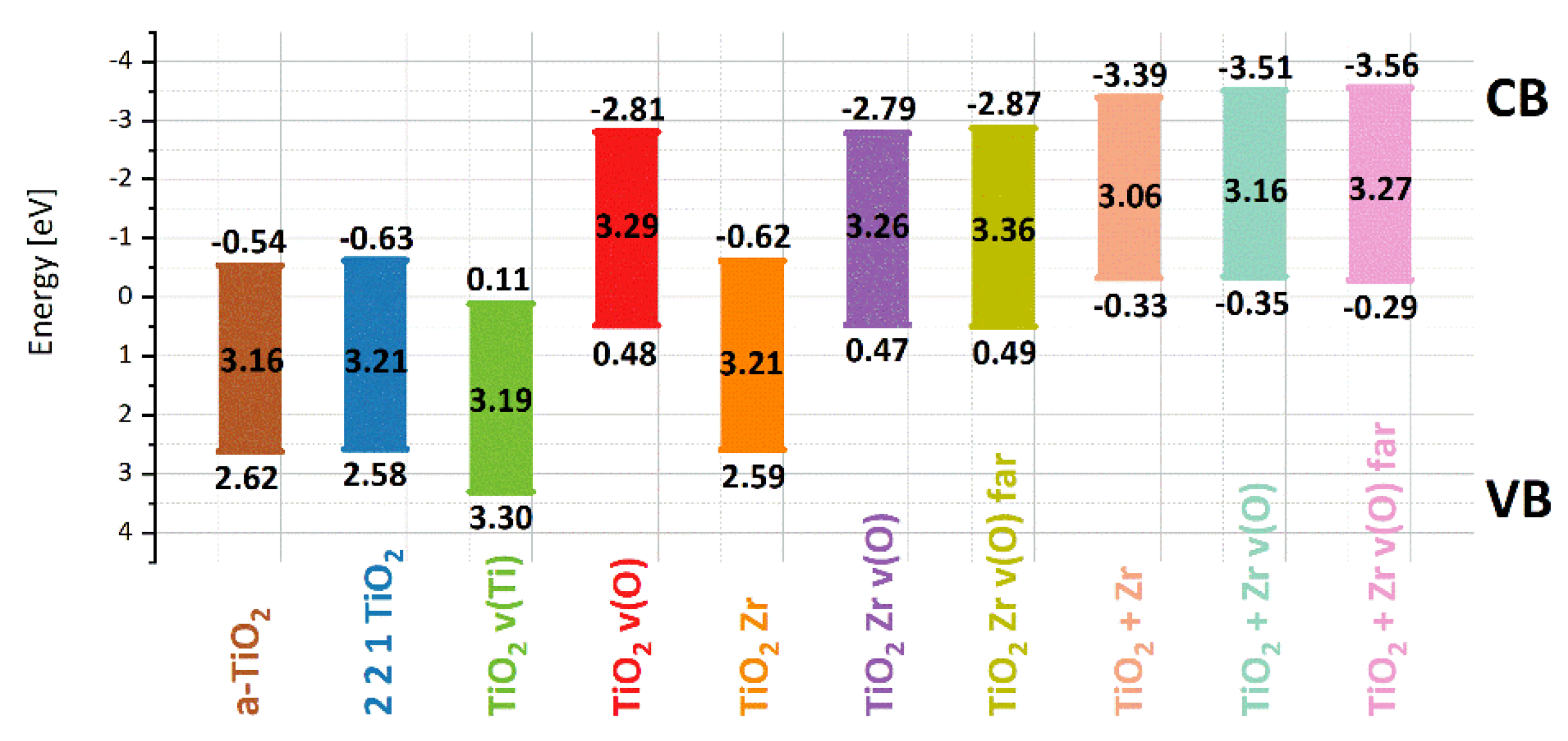
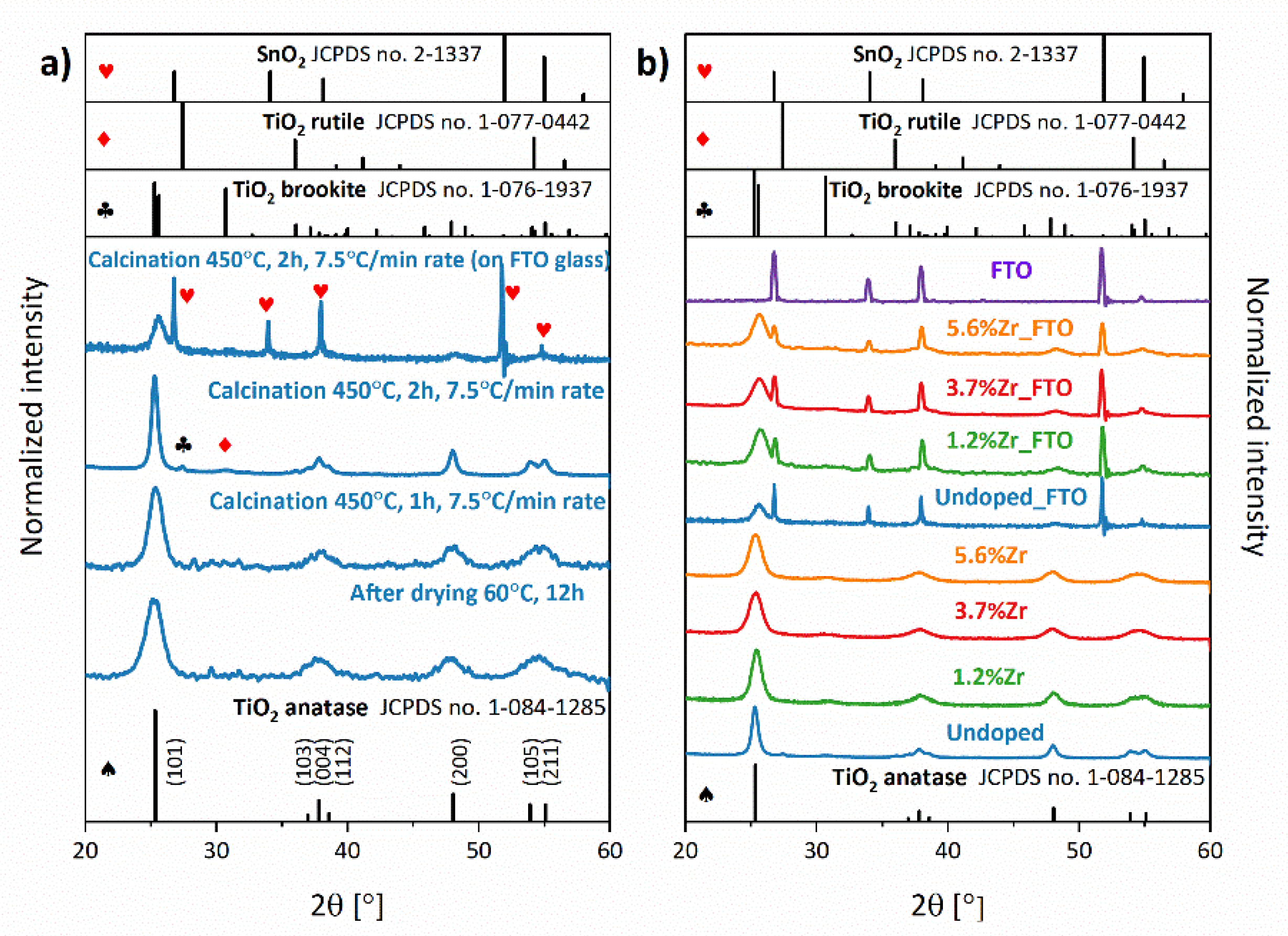
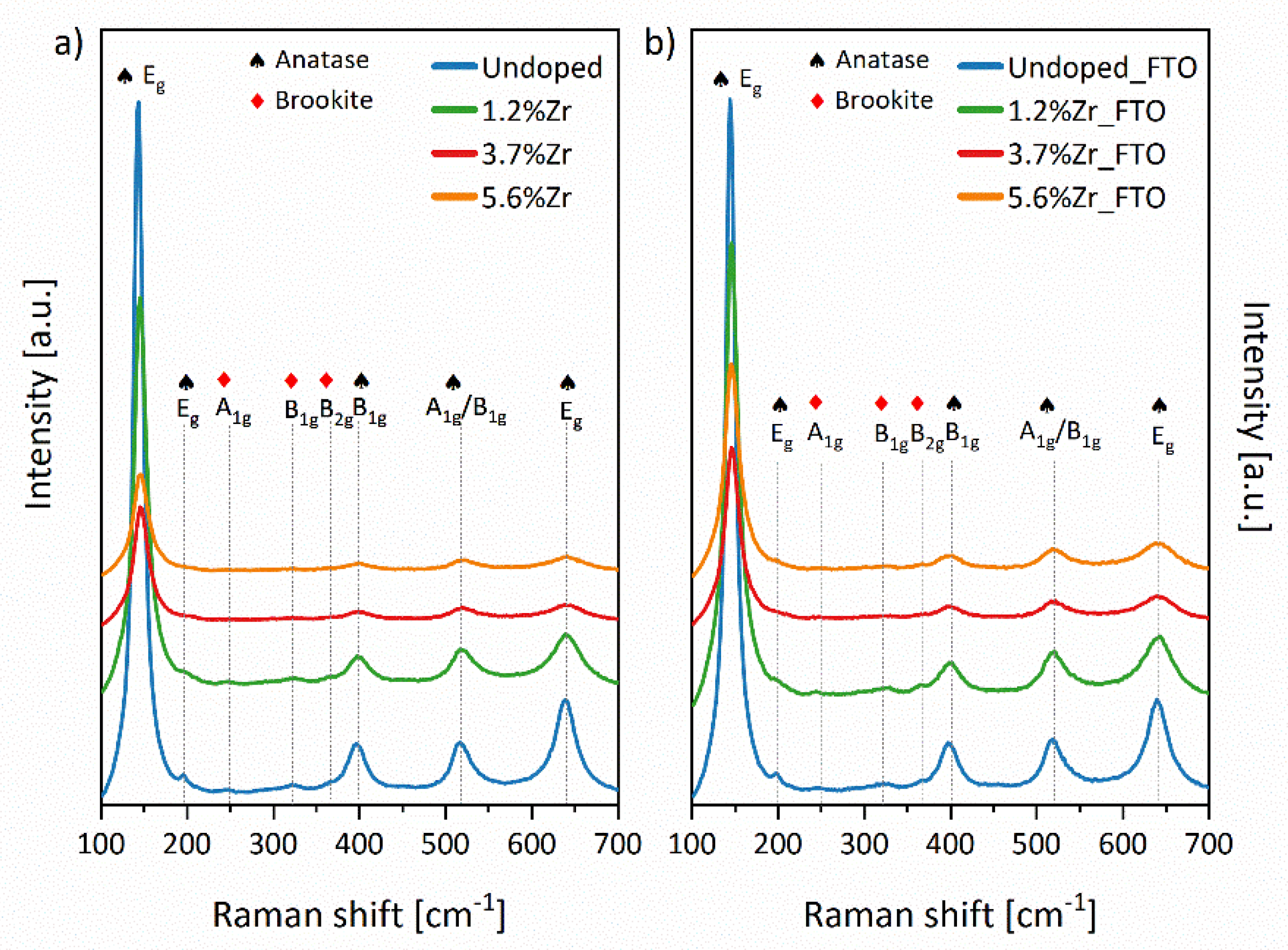

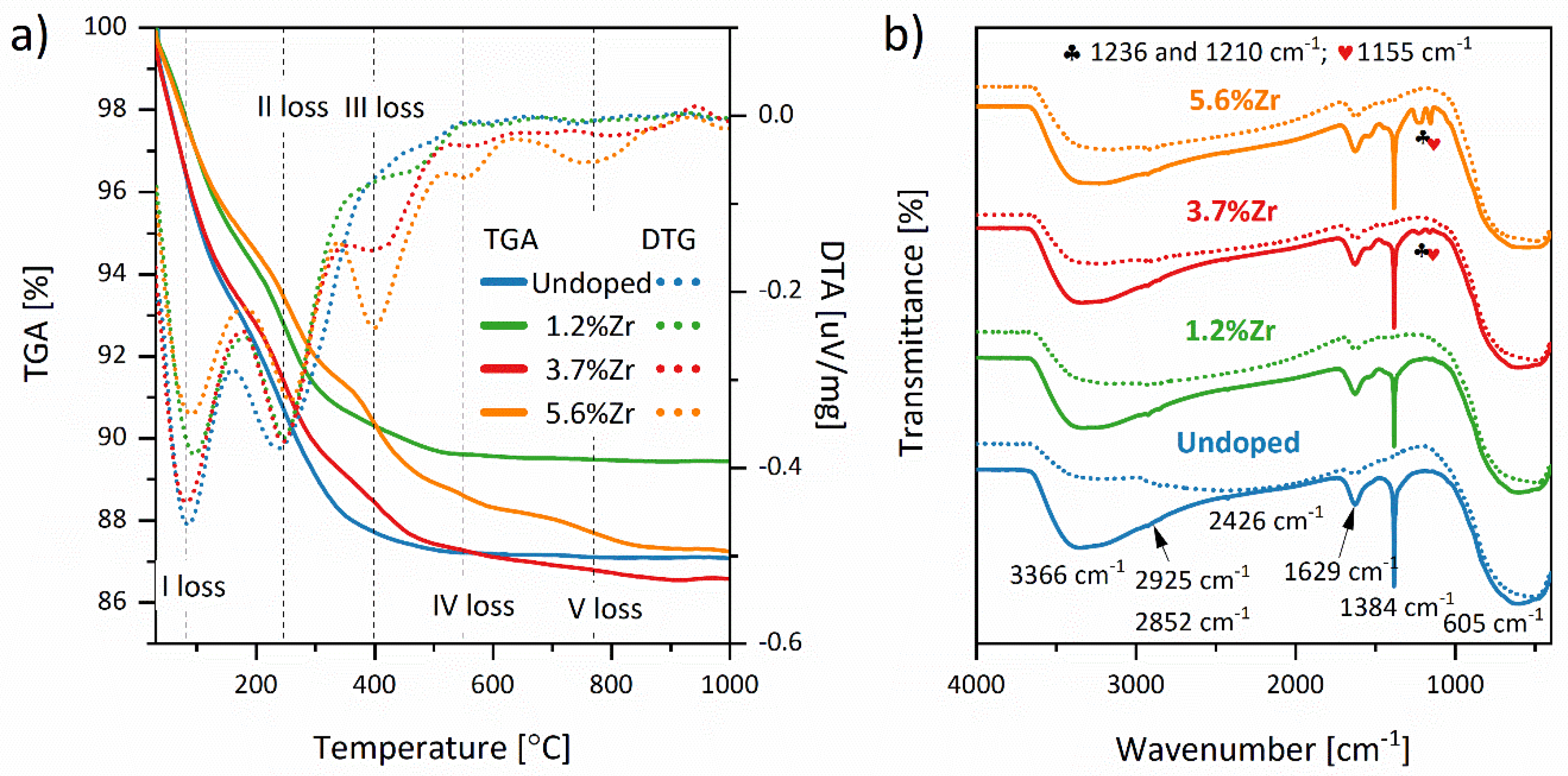
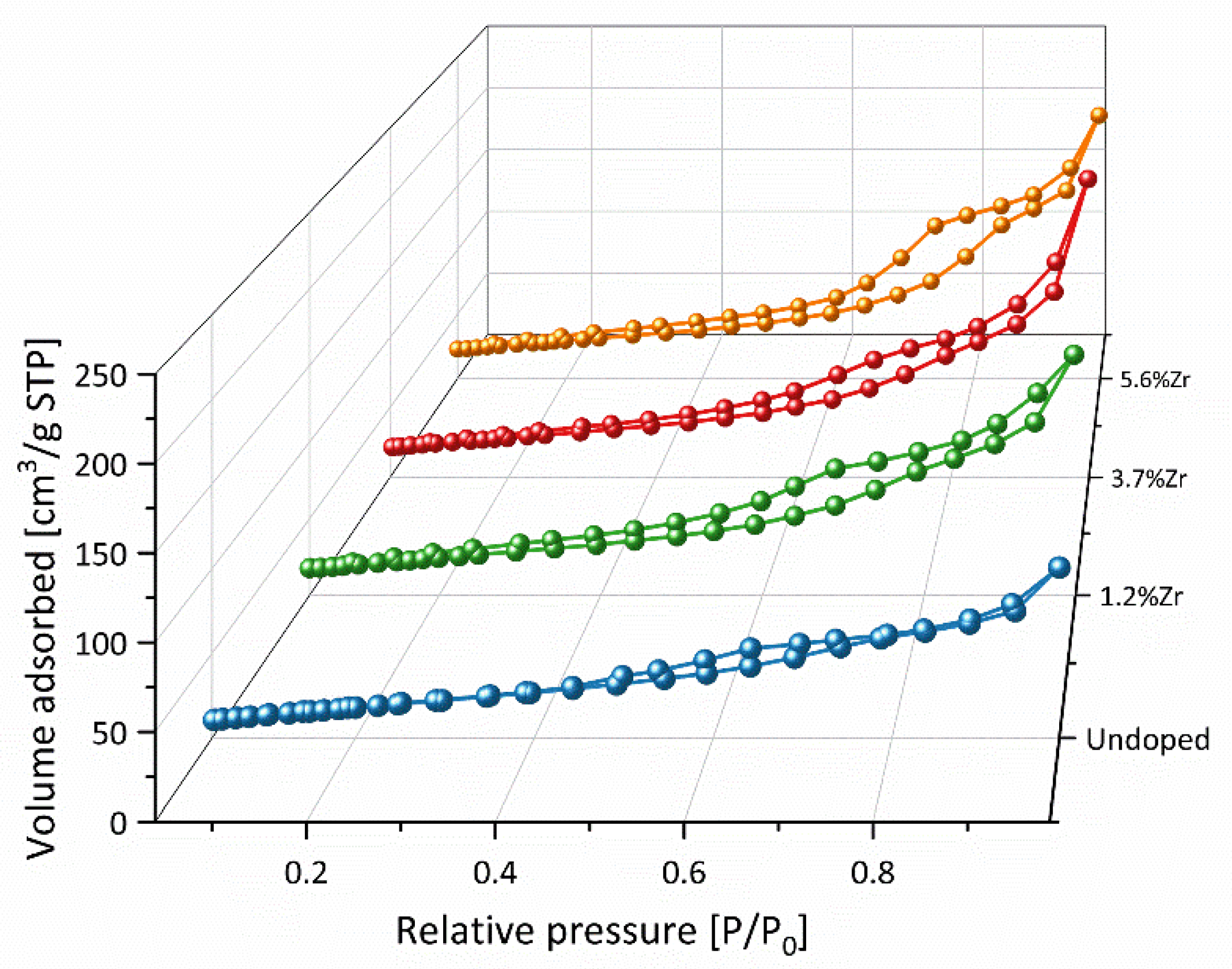
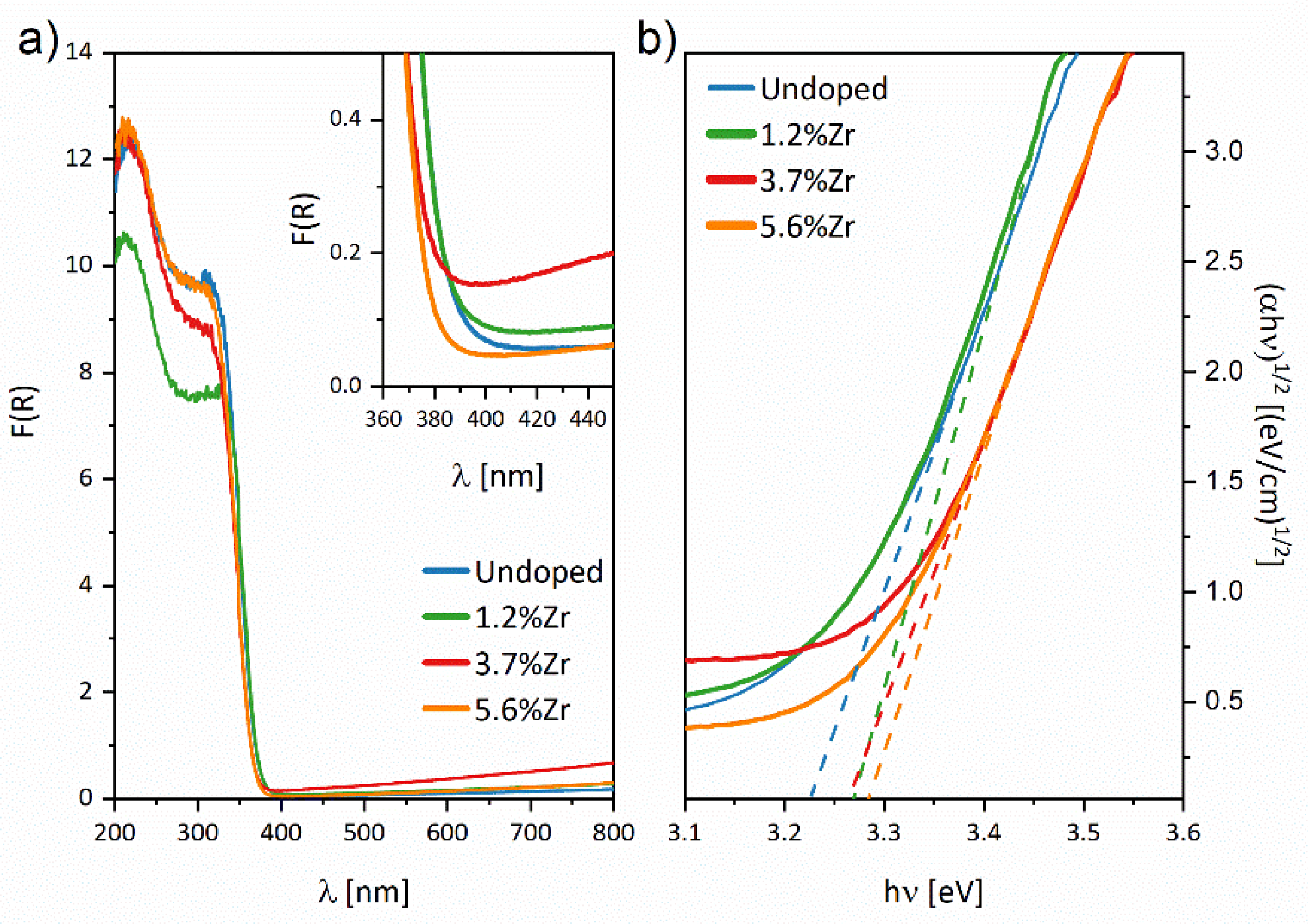
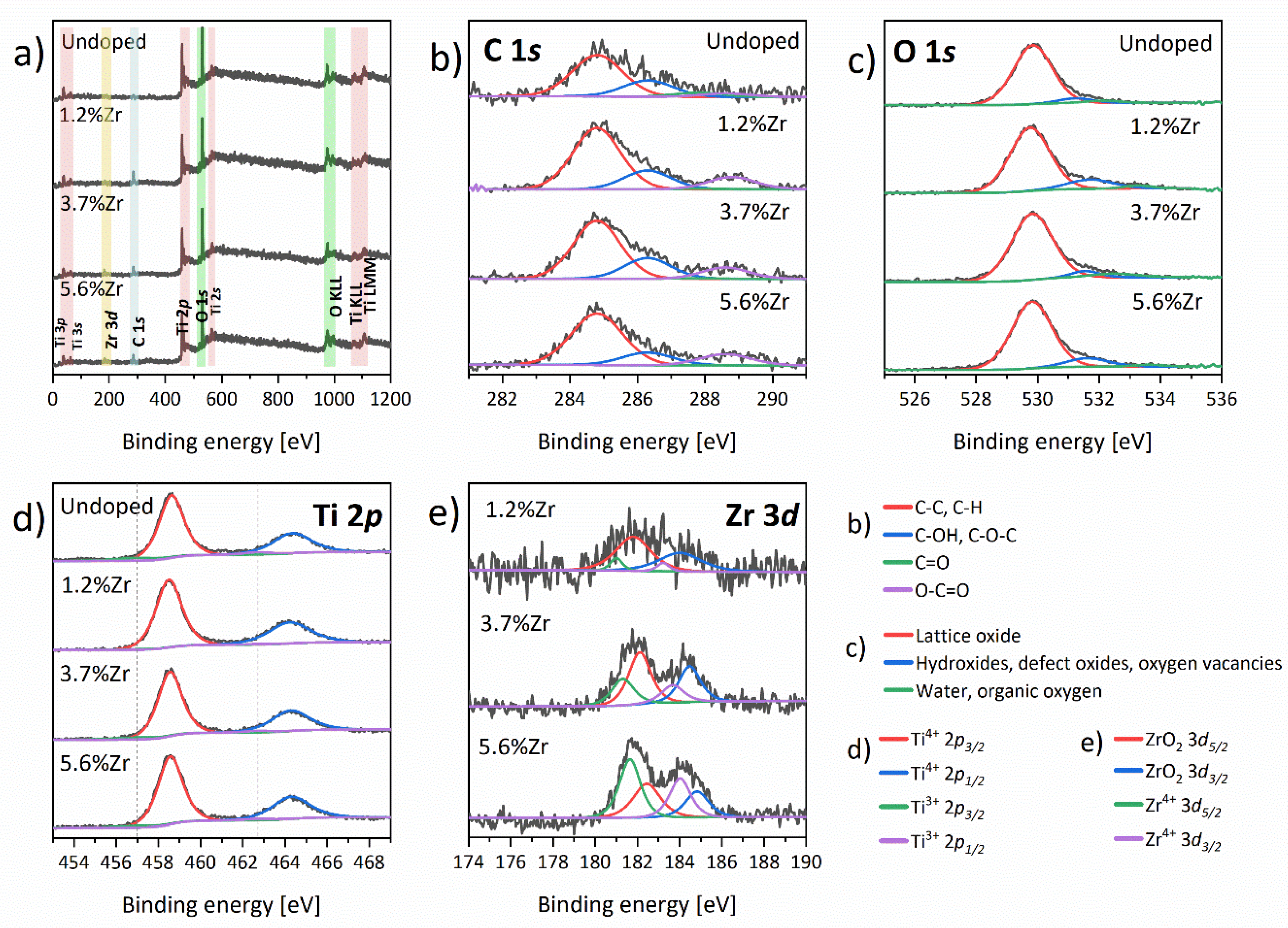
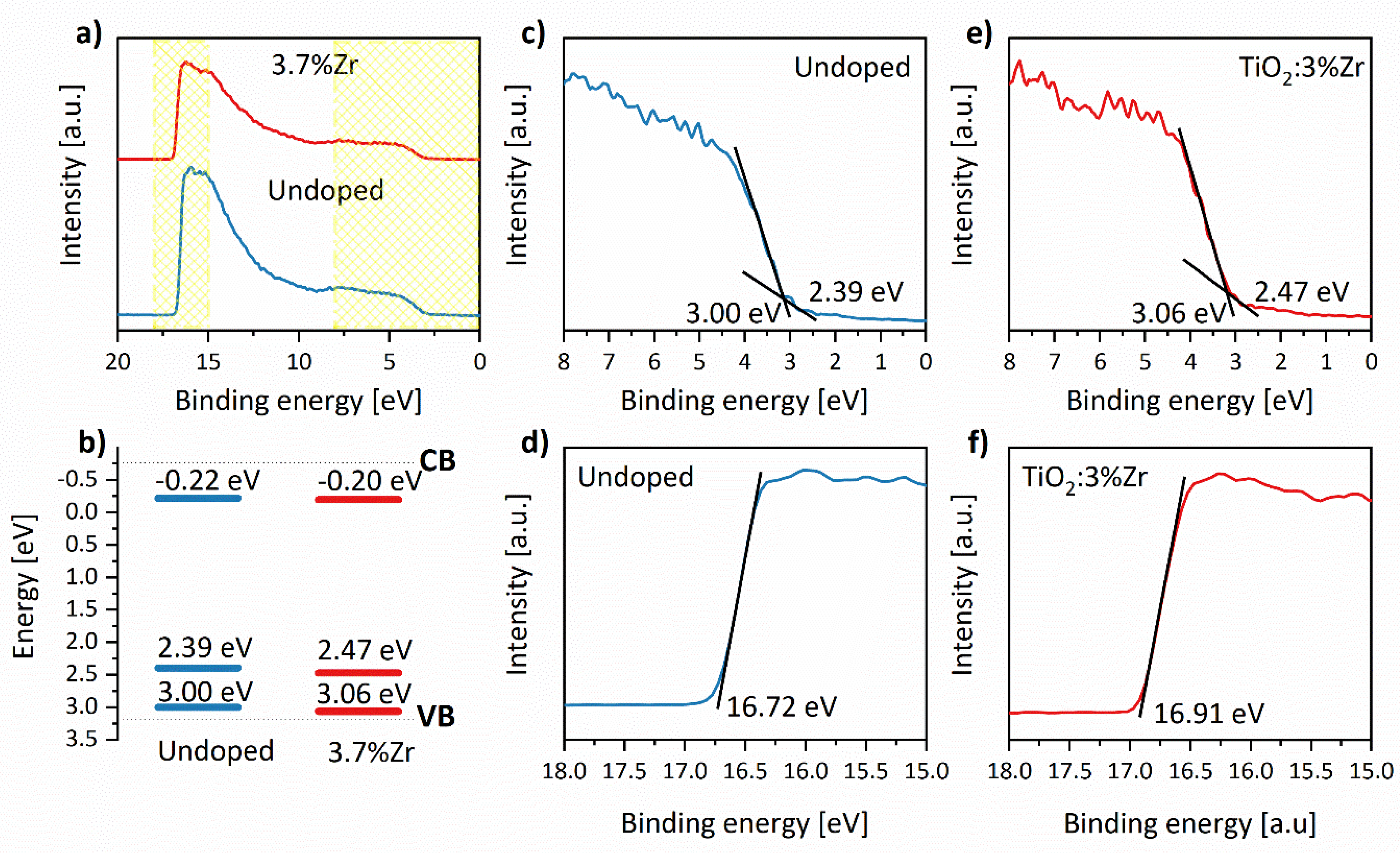


| Dopant | Phase | Annealling Temp. [°C] | JSC [mA/cm2] | VOC [V] | FF [%] | η [%] | Ref. |
|---|---|---|---|---|---|---|---|
| 5% Zr | Anatase | 450 | 0.017 | 0.71 | 20 | <1 | [19] |
| 10% Zr | Anatase | 400 | 0.13 | 0.45 | 0.34 | 0.02 | [20] |
| 5% Zr | Anatase | 600 | 10.66 | 0.64 | 61 | 4.16 | [24] |
| 0.5% Zr | Anatase | 450 | 21.83 | 0.65 | 53 | 7.52 | [21] |
| 2% Zr | Anatase | 500 | 6.28 | 0.787 | 63.2 | 3.12 | [22] |
| 0.3% Zr | Anatase | 500 | 12.91 | 0.7239 | 72 | 6.7 | [23] |
| 1% Zr | Anatase | 500 | 7.74 | 0.82 | 71.1 | 4.51 | [25] |
| 3.7% Zr | Anatase + Brookite | 450 | 15.47 | 0.7641 | 72.97 | 8.63 | This study |
| Structure | a (a = b) [Å] | c [Å] | c/a | Total Energy/Atom [eV] |
|---|---|---|---|---|
| a-TiO2 | 3.85 | 9.71 | 2.52 | −8.74 |
| 3.79 [38,39,40] | 9.51 | 2.51 | − | |
| t-ZrO2 | 3.67 | 5.21 | 1.50 | −9.27 |
| 3.59 [36] | 5.19 | 1.44 | − | |
| 3.64 [37] | 5.27 | 1.45 | − | |
| 2 × 2 × 1 TiO2 | 7.69 | 9.70 | 2.52 | −8.73 |
| 2 × 2 × 1 TiO2 v(Ti) | 7.72 | 9.62 | 2.49 | −8.43 |
| 2 × 2 × 1 TiO2 v(O) | 7.68 | 9.72 | 2.53 | −8.70 |
| 2 × 2 × 1 TiO2Zr * | 7.72 | 9.77 | 2.53 | −8.78 |
| 2 × 2 × 1 TiO2 Zr v(O) * | a = 7.72 b =7.69 | 9.78 | 2.49 2.51 | −8.74 |
| 2 × 2 × 1 TiO2 Zr v(O) * far | a =7.72 b = 7.70 | 9.79 | 2.56 2.54 | −8.75 |
| 2 × 2 × 1 TiO2+Zr ** | a = 7.73 b = 7.79 | 9.70 | 2.51 2.49 | −8.70 |
| 2 × 2 × 1 TiO2+Zr v(O) | a = 7.73 b = 7.84 | 9.72 | 2.51 2.48 | −8.68 |
| 2 × 2 × 1 TiO2+Zr v(O) far | a = 7.69 b = 7.86 | 9.72 | 2.53 2.47 | −8.67 |
| Structure | Ebg [eV] |
|---|---|
| a-TiO2 | 3.16 |
| 2 × 2 × 1 TiO2 | 3.21 |
| 2 × 2 × 1 TiO2 v(O) | 3.29 |
| 2 × 2 × 1 TiO2 v(Ti) | 3.19 |
| 2 × 2 × 1 TiO2 Zr | 3.21 |
| 2 × 2 × 1 TiO2 Zr v(O) | 3.26 |
| 2 × 2 × 1 TiO2 Zr v(O) far | 3.36 |
| 2 × 2 × 1 TiO2 + Zr | 3.06 |
| 2 × 2 × 1 TiO2 + Zr v(O) | 3.16 |
| 2 × 2 × 1 TiO2 +Zr v(O) far | 3.27 |
| Sample | Dhkl [nm] | a = b [Å] | c [Å] | Cell volume [Å] |
|---|---|---|---|---|
| TiO2_FTO | 7.61 | 3.7948 | 9.5616 | 134.5931 |
| TiO2:1.3%Zr_FTO | 6.73 | 3.7896 | 9.5204 | 133.5283 |
| TiO2:3.7%Zr_FTO | 5.91 | 3.7976 | 9.5368 | 134.6059 |
| TiO2:5.6%Zr_FTO | 6.75 | 3.7936 | 9.5520 | 134.5368 |
| TiO2 (60 °C, 12 h) | 4.89 | 3.8018 | 9.5060 | 137.5812 |
| TiO2 (450 °C, 1 h) | 6.44 | 3.7868 | 9.4664 | 135.9226 |
| TiO2 (450 °C, 2 h) | 12.85 | 3.7884 | 9.5096 | 136.5429 |
| TiO2:1.3%Zr | 8.33 | 3.7834 | 9.4808 | 135.7306 |
| TiO2:3.7%Zr | 6.56 | 3.7888 | 9.4976 | 136.4813 |
| TiO2:5.6%Zr | 6.62 | 3.7920 | 9.5176 | 136.7810 |
| Sample | ABET [m2/g] | Vp [cm3/g] | Sp [nm] |
|---|---|---|---|
| Undoped | 69.4 | 0.156 | 3.8 |
| 1.2%Zr | 89.1 | 0.238 | 5.5 |
| 3.7%Zr | 101.0 | 0.325 | 5.5 |
| 5.6%Zr | 132.9 | 0.280 | 7.5 |
| Sample | Ebg [eV] |
|---|---|
| Undoped | 3.22 |
| 1.2%Zr | 3.27 |
| 3.7%Zr | 3.26 |
| 5.6%Zr | 3.28 |
| Sample | VOC [mV] | JSC [mA/cm2] | FF [%] | η [%] | Ndye [nmol/cm2] | IPCE [%] | R1 [Ω] | R2 [Ω] | R3 [Ω] | τ [ms] |
|---|---|---|---|---|---|---|---|---|---|---|
| P25 | 756.1 | 13.62 | 72.71 | 7.49 | 46.55 | 68.1 | 14.29 | 4.985 | 30.24 | 5.49 |
| Undoped | 779.1 | 13.50 | 70.39 | 7.41 | 16.62 | 68.6 | 17.34 | 4.785 | 30.79 | 10.18 |
| 1.2%Zr | 767.1 | 14.68 | 70.66 | 7.96 | 27.36 | 78.8 | 18.99 | 6.682 | 26.26 | 15.96 |
| 3.7%Zr | 764.1 | 15.47 | 72.97 | 8.63 | 33.76 | 84.3 | 17.28 | 6.246 | 22.70 | 12.76 |
| 5.6%Zr | 768.1 | 11.63 | 75.45 | 6.74 | 43.85 | 63.8 | 13.6 | 10.46 | 24.21 | 10.18 |
Publisher’s Note: MDPI stays neutral with regard to jurisdictional claims in published maps and institutional affiliations. |
© 2021 by the authors. Licensee MDPI, Basel, Switzerland. This article is an open access article distributed under the terms and conditions of the Creative Commons Attribution (CC BY) license (https://creativecommons.org/licenses/by/4.0/).
Share and Cite
Bartkowiak, A.; Korolevych, O.; Chiarello, G.L.; Makowska-Janusik, M.; Zalas, M. How Can the Introduction of Zr4+ Ions into TiO2 Nanomaterial Impact the DSSC Photoconversion Efficiency? A Comprehensive Theoretical and Experimental Consideration. Materials 2021, 14, 2955. https://doi.org/10.3390/ma14112955
Bartkowiak A, Korolevych O, Chiarello GL, Makowska-Janusik M, Zalas M. How Can the Introduction of Zr4+ Ions into TiO2 Nanomaterial Impact the DSSC Photoconversion Efficiency? A Comprehensive Theoretical and Experimental Consideration. Materials. 2021; 14(11):2955. https://doi.org/10.3390/ma14112955
Chicago/Turabian StyleBartkowiak, Aleksandra, Oleksandr Korolevych, Gian Luca Chiarello, Malgorzata Makowska-Janusik, and Maciej Zalas. 2021. "How Can the Introduction of Zr4+ Ions into TiO2 Nanomaterial Impact the DSSC Photoconversion Efficiency? A Comprehensive Theoretical and Experimental Consideration" Materials 14, no. 11: 2955. https://doi.org/10.3390/ma14112955
APA StyleBartkowiak, A., Korolevych, O., Chiarello, G. L., Makowska-Janusik, M., & Zalas, M. (2021). How Can the Introduction of Zr4+ Ions into TiO2 Nanomaterial Impact the DSSC Photoconversion Efficiency? A Comprehensive Theoretical and Experimental Consideration. Materials, 14(11), 2955. https://doi.org/10.3390/ma14112955







